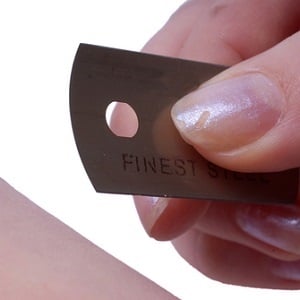
Your colleague, housemate or boss might - in the privacy of their bathroom - be taking a knife, razor blade or safety pin, and cutting themselves: light, superficial slices across the wrist or thigh, deep enough to bleed, but not deep enough to kill.
Obviously, it's potentially dangerous behaviour. Cutters can lose so much blood that they pass out, and they're vulnerable to infections. They may misjudge the depth of the cut, and need stitches, or need to be hospitalised.
But the real issue is emotional. When somebody self-mutilates, they have more than surface damage - they have deep emotional and physical scars. Many times, no one comes to the rescue, as self-mutilation usually happens behind closed doors, and the evidence covered up.
Who does it and why?
Self-mutilation usually occurs in families which do not have open communication channels. Cutters are usually middle or upper class, well-educated, and have above-average intelligence. It's more common among teenagers and young women, but by no means restricted to them.
Self-mutilation affects more females than males: it is estimated that only 20-25 percent of people who self-harm are male.
Many who self-mutilate do not aim to hurt themselves permanently, and they often do not mean to continue with the behaviour. Experts believe they rarely have the intention to commit suicide, but rather do it to get immediate relief from emotional pain.
Self-mutilation often becomes an addiction and is used as a form of escapism. Those who have suffered a traumatic experience could start mutilating themselves. Even living through violence could lead to the start of a self-mutilating habit.
Many of those who cut themselves see self-mutilation as a coping mechanism: they substitute emotional pain they with physical pain. It is suspected that those who self-mutilate have not developed healthy coping mechanisms. When they reach a point where their emotions surge to unbearable heights, they opt to do dangerous things to themselves. It is a roundabout way to regain a sense of control.
The roots of this behaviour may lie in a glitch in the parent-child relationship. In many cases, the child sees itself as the problem person, rather than observing family dynamics as a whole. If the problem of self-mutilation is ignored, it will simply not just go away.
Emotions
Those who cut themselves, substitute emotional pain with physical pain. A cycle of addiction starts: the person experiences an adrenaline rush and feels euphoric for a while. The emotional pain becomes unbearable and the physical pain, although unpleasant, is something they can cope with.
Feelings which self-mutilators find difficult to express could range from anger, hurt and shame, to frustration and depression.
People who cut themselves may also have a mental illness. It is associated with conditions such as bipolar disorder, anorexia, bulimia, obsessive compulsive disorder (OCD) and depression.
What it feels like
If done often, the brain eventually starts to associate abusive activities with a sense of relief. It starts as an impulse which many have described as a sudden switch from their normal everyday behaviour to an episode of self-harm.
At first, in the case of cutting, the feeling is good. Once the realisation of what has been done kicks in, self-mutilators feel guilty, and try and purge this by opening up the wounds again. Cuts are usually along the wrists, arms, legs and stomachs.
Self-harm can also affect the body image of the victim. They begin to feel comfortable with bruises and lesions on their skin. Self-harm give the person a feeling of immense control in a world in which they feel they lack control.
Getting help
If you have been cutting and want to stop, talk to someone you trust. Identify situations and what triggers you to cut yourself, and seek professional help.
Here are a few tips that can help you to stop cutting:
- Distract yourself: call a friend, go for a walk, watch TV, play with a pet;
- Calm yourself: do breathing exercises, yoga exercises, listen to soothing music;
- Express your pain: draw or scribble on paper using a red pen, write about your hurt, anger or pain, draw your pain;
- Substitute the cutting sensation: rub a piece of ice on your skin, wear a rubber band around your wrist and snap it gently against your skin, draw on your skin with a soft-tipped red pen on the place where you might usually cut.
How to help
If you discover that a friend is self-mutilating, you should try and understand why this is happening. It is also important that someone who self-mutilates be referred to a professional.
Here are a few tips on helping a friend who cuts:
- Talk about it, acknowledge, share, and try to understand what your friend is going through;
- Tell someone whom you can trust to give you guidance;
- Find ways of helping your friend with their problems;
- When you feel you have created a feeling of trust with your friend, encourage them to see a professional; and
- Never deliver an ultimatum, no matter what the situation might be.




 Publications
Publications
 Partners
Partners










